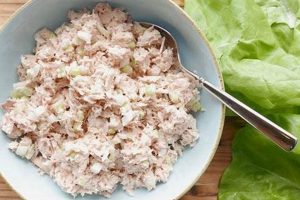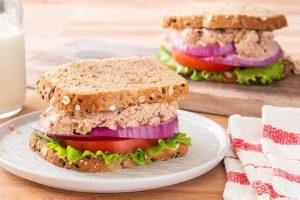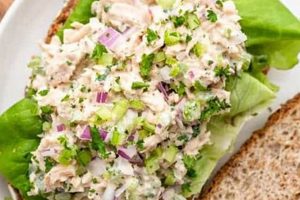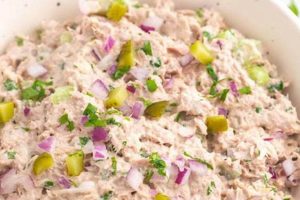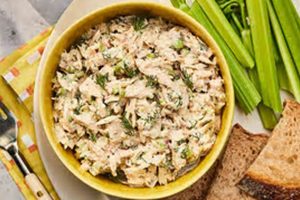A healthful approach to a classic dish focuses on reducing caloric content without sacrificing flavor or satisfaction. This is often achieved through ingredient substitutions, such as using Greek yogurt or avocado in place of mayonnaise, and incorporating plenty of fresh vegetables like celery, red onion, and bell peppers. A typical lighter preparation might involve canned tuna packed in water, a minimal amount of healthy fat, and a focus on lean protein and fiber.
Health-conscious individuals often seek recipes with reduced calories to manage weight, improve overall well-being, and adhere to specific dietary guidelines. A lighter version of this traditional favorite provides a nutritious and protein-rich meal option, perfect for lunch, a light dinner, or as part of a balanced meal plan. The evolution of such recipes reflects broader dietary trends towards healthier eating and a focus on fresh, whole ingredients.
The following sections will delve into specific ingredient choices, preparation methods, nutritional information, and creative variations for crafting delicious and satisfying lighter tuna salads.
Tips for Creating Delicious Lighter Tuna Salad
Achieving a flavorful yet calorie-conscious tuna salad involves careful ingredient selection and preparation techniques. The following tips offer guidance for maximizing flavor and minimizing caloric impact.
Tip 1: Opt for Tuna Packed in Water: Selecting tuna packed in water significantly reduces overall fat and calorie content compared to tuna packed in oil.
Tip 2: Embrace Greek Yogurt: Substituting plain nonfat Greek yogurt for mayonnaise offers a significant calorie reduction while adding a creamy texture and a boost of protein.
Tip 3: Maximize Fresh Vegetables: Incorporating a variety of chopped vegetables, such as celery, red onion, bell peppers, and carrots, adds flavor, texture, and essential nutrients while also increasing volume and reducing the need for higher-calorie ingredients.
Tip 4: Explore Flavorful Herbs and Spices: Fresh dill, parsley, chives, or a dash of cayenne pepper can elevate the flavor profile without adding extra calories.
Tip 5: Utilize Avocado Wisely: While avocado provides healthy fats, it is calorie-dense. Use it sparingly as a partial mayonnaise substitute for creaminess and flavor.
Tip 6: Consider a Squeeze of Lemon: A touch of lemon juice brightens the flavor and adds a refreshing tang.
Tip 7: Portion Control: Even with healthier ingredients, mindful portioning contributes to calorie management.
By employing these strategies, one can create a satisfying and nutritious tuna salad that aligns with health-conscious dietary goals.
These tips provide a foundation for crafting a personalized, lighter tuna salad. Experimentation with different ingredients and flavor combinations can lead to a truly enjoyable and healthy culinary experience.
1. Ingredient Selection
Ingredient selection is paramount in creating a truly low-calorie tuna salad. Careful choices directly impact not only the nutritional profile but also the overall flavor and texture of the final dish. Strategic substitutions and mindful inclusions are key to achieving a satisfying and healthy meal.
- Tuna:
Opting for tuna packed in water instead of oil significantly reduces fat and calories. Draining the tuna thoroughly further minimizes any residual liquid and its potential contribution to excess sodium. Choosing chunk light tuna offers a milder flavor profile compared to albacore, but both are suitable for low-calorie preparations.
- Base:
Traditional mayonnaise contributes significantly to the calorie content of tuna salad. Substituting plain nonfat Greek yogurt offers a substantial calorie reduction while maintaining a creamy texture and adding a protein boost. Alternatively, mashed avocado can provide a healthy fat source and contribute to a creamy consistency, though it should be used sparingly due to its higher calorie density. A combination of Greek yogurt and avocado offers a balanced approach.
- Vegetables:
Incorporating a variety of fresh vegetables not only adds crucial vitamins, minerals, and fiber, but also increases volume and textural complexity without significantly impacting calorie count. Chopped celery, red onion, bell peppers, and carrots are excellent choices, providing both flavor and nutritional benefits. Finely diced cucumber or chopped water chestnuts can add a refreshing crunch.
- Flavor Enhancers:
Fresh herbs, spices, and a touch of acidity enhance the flavor profile without adding extra calories. Dill, parsley, chives, and cilantro are excellent choices. A pinch of cayenne pepper or a dash of hot sauce can add a spicy kick. Lemon juice or a splash of apple cider vinegar provides brightness and balances the richness of the other ingredients.
The interplay of these ingredient choices ultimately determines the success of a low-calorie tuna salad. A balanced approach that considers both nutritional value and flavor ensures a satisfying and healthful meal.
2. Calorie Reduction
Calorie reduction is central to the concept of a low-calorie tuna salad recipe. Achieving a significant decrease in caloric content requires strategic modifications to traditional preparation methods and ingredient choices. This involves understanding the caloric contribution of various components and employing techniques to minimize those contributions without compromising palatability.
- Ingredient Substitution:
Replacing mayonnaise, a high-calorie ingredient, with lower-calorie alternatives like plain nonfat Greek yogurt or a small amount of mashed avocado significantly reduces overall caloric content. This substitution also alters the nutritional profile, often increasing protein and decreasing saturated fat. For example, one tablespoon of mayonnaise contains approximately 90 calories, while the same amount of plain nonfat Greek yogurt contains around 10 calories. This simple swap can dramatically reduce the calorie count of the final dish.
- Emphasis on Lean Protein and Fiber:
Prioritizing lean protein sources, such as tuna packed in water, and incorporating high-fiber vegetables increases satiety and contributes to a lower calorie density. Fiber-rich foods like celery, carrots, and bell peppers add bulk and texture without contributing many calories. This helps create a more voluminous salad that is satisfying without being calorie-dense.
- Portion Control:
Mindful portioning plays a crucial role in calorie management. Even with healthier ingredients, consuming large portions can negate calorie-reducing efforts. Using smaller bowls or plates and pre-portioning servings can assist in regulating intake and maintaining a calorie deficit, if desired. Being aware of serving sizes and using measuring tools can help ensure appropriate calorie consumption.
- Preparation Methods:
Draining canned tuna thoroughly removes excess water and sodium, which indirectly contributes to calorie reduction by limiting water retention and potentially reducing appetite for high-calorie snacks later. Opting for grilling or baking instead of frying for any accompanying protein further minimizes added calories from cooking oils. These small steps contribute to a more calorie-conscious meal.
These calorie reduction strategies are integral to formulating a truly low-calorie tuna salad recipe. By understanding the impact of each component and employing mindful preparation techniques, a delicious and satisfying meal can be created without compromising dietary goals.
3. Flavor Enhancement
Flavor enhancement is crucial in low-calorie tuna salad recipes. Reducing caloric content often necessitates omitting or substituting ingredients that contribute significantly to flavor. Therefore, strategic flavor enhancement techniques become essential to compensate for these reductions and create a palatable and enjoyable dish. Balancing reduced calories with robust flavor is key to the success of such recipes.
- Fresh Herbs:
Fresh herbs provide a significant flavor boost without adding calories. Dill, parsley, chives, and cilantro are excellent choices, complementing the tuna and other ingredients. These herbs offer distinct flavor profiles, from dill’s slight anise note to cilantro’s bright, citrusy flavor. Incorporating a combination of herbs can create a complex and layered taste experience, compensating for the reduced richness from lower-calorie ingredients.
- Spices:
Spices offer a potent way to enhance flavor without adding calories. A pinch of cayenne pepper or a dash of hot sauce can introduce a welcome heat, while black pepper, paprika, or garlic powder can add depth and complexity. The strategic use of spices can elevate the overall flavor profile, making the salad more satisfying despite its lower calorie count. Experimenting with different spice combinations can create unique and personalized flavor profiles.
- Acidity:
A touch of acidity brightens the flavors of a low-calorie tuna salad. Lemon juice, lime juice, or apple cider vinegar provide a refreshing tang that cuts through the richness of the other ingredients. Acidity balances the flavors and prevents the salad from tasting bland, a common concern when reducing calorie-dense components. This element is crucial in creating a vibrant and enjoyable culinary experience.
- Aromatics:
Incorporating aromatic vegetables, such as finely diced red onion or shallots, can significantly enhance the flavor profile. These ingredients contribute a pungent, slightly sweet flavor that adds depth and complexity to the salad. The aromatics meld with the other ingredients, creating a more nuanced and satisfying flavor profile that compensates for any perceived loss of richness from calorie reduction.
These flavor enhancement techniques are essential for creating a delicious and satisfying low-calorie tuna salad. By focusing on fresh, flavorful ingredients and employing strategic combinations, a truly enjoyable meal can be created without sacrificing dietary goals. The interplay of herbs, spices, acidity, and aromatics elevates the sensory experience, demonstrating that healthy eating can be both flavorful and fulfilling.
4. Nutritional Value
Nutritional value is a critical consideration in a low-calorie tuna salad recipe. While reducing caloric intake is important, maintaining a balance of essential nutrients is paramount for overall health and well-being. A well-crafted recipe maximizes nutrient density while minimizing empty calories, offering a nutritious and satisfying meal option.
The nutritional profile of a low-calorie tuna salad is directly influenced by ingredient choices. Tuna, a lean protein source, provides essential amino acids and omega-3 fatty acids. Opting for tuna packed in water minimizes saturated fat intake compared to oil-packed varieties. The inclusion of fresh vegetables, such as celery, bell peppers, and red onion, contributes vitamins, minerals, and dietary fiber. Fiber promotes satiety, aids digestion, and contributes to overall health. Substituting Greek yogurt for mayonnaise adds protein and calcium while reducing saturated fat and cholesterol. Mindful ingredient selection ensures the recipe delivers a balanced nutritional profile that supports health goals.
For example, a low-calorie tuna salad featuring tuna packed in water, Greek yogurt, chopped celery, red onion, and a squeeze of lemon juice offers a balanced combination of protein, healthy fats, complex carbohydrates, and essential micronutrients. Such a recipe aligns with dietary guidelines that emphasize lean protein, whole grains, and a variety of fruits and vegetables. The practical significance of understanding nutritional value in this context lies in the ability to create meals that support both weight management and overall health. A nutritionally balanced, low-calorie tuna salad provides sustained energy, promotes satiety, and contributes to long-term well-being, demonstrating that healthy eating need not compromise flavor or satisfaction.
5. Preparation Methods
Preparation methods significantly influence the final outcome of a low-calorie tuna salad recipe. Careful consideration of techniques, from ingredient handling to mixing and chilling, impacts not only the flavor and texture but also the nutritional integrity and overall calorie content. Efficient and mindful preparation contributes to a successful, healthy, and satisfying dish.
- Draining Excess Liquid:
Thoroughly draining canned tuna, whether packed in water or oil, is crucial for minimizing excess sodium and unwanted calories. Residual liquid contributes unnecessary moisture, diluting flavor and potentially increasing sodium content. Proper draining ensures a firmer texture and a more concentrated flavor profile.
- Ingredient Incorporation:
Gentle mixing of ingredients prevents over-processing and maintains the desired texture. Over-mixing can result in a mushy consistency, particularly when using delicate ingredients like avocado or flaked tuna. A light hand preserves the individual textures of the components, contributing to a more appealing and palatable final product.
- Chilling Time:
Chilling the prepared tuna salad allows the flavors to meld and enhances the overall sensory experience. Chilling firms the texture, making it easier to handle for sandwiches or wraps. This step also improves food safety by inhibiting bacterial growth. A minimum of 30 minutes of chilling is recommended for optimal flavor development and food safety.
- Storage Techniques:
Proper storage maintains freshness and prevents spoilage. Storing the prepared tuna salad in an airtight container in the refrigerator extends its shelf life and preserves its quality. Prompt refrigeration after preparation is crucial for food safety and minimizes the risk of bacterial contamination. Proper storage ensures the tuna salad remains safe and enjoyable for consumption for several days.
These preparation methods are integral to creating a successful low-calorie tuna salad. Attention to detail in each step, from draining to storage, ensures optimal flavor, texture, and nutritional value while adhering to calorie-conscious goals. Mindful preparation elevates the final product, transforming simple ingredients into a satisfying and healthful meal.
Frequently Asked Questions
This section addresses common inquiries regarding low-calorie tuna salad recipes, providing concise and informative responses to facilitate informed dietary choices.
Question 1: What is the most effective way to reduce calories in tuna salad?
Substituting plain nonfat Greek yogurt for mayonnaise offers the most significant calorie reduction. This substitution also increases protein content and reduces saturated fat.
Question 2: Can avocado be used in a low-calorie tuna salad?
Avocado can be incorporated, but sparingly. While offering healthy fats and creaminess, it is calorie-dense. A small amount can enhance flavor and texture without significantly increasing caloric content.
Question 3: How can sodium content be minimized in low-calorie tuna salad?
Selecting tuna packed in water and thoroughly draining it minimizes sodium. Rinsing the tuna under cold water can further reduce sodium, though some flavor may be lost. Using fresh herbs and spices instead of salt for seasoning also helps control sodium levels.
Question 4: What are the best vegetables to add to low-calorie tuna salad?
Nutrient-rich, low-calorie vegetables such as celery, red onion, bell peppers, and carrots are excellent choices. These vegetables contribute flavor, texture, and essential vitamins and minerals without significantly impacting calorie count.
Question 5: How long can low-calorie tuna salad be stored in the refrigerator?
Properly stored in an airtight container, low-calorie tuna salad can typically be refrigerated for 3 to 5 days. Spoilage indicators include a sour odor or a change in texture.
Question 6: Can low-calorie tuna salad be frozen?
Freezing is not generally recommended. Freezing can negatively impact the texture of the tuna and other ingredients, resulting in a watery consistency upon thawing. It’s best to prepare and consume the salad within a few days for optimal quality.
Understanding these common concerns facilitates successful preparation and enjoyment of healthy, low-calorie tuna salad.
The following section offers a collection of recipe variations to explore diverse flavor profiles and cater to individual preferences.
Conclusion
Exploration of low-calorie tuna salad recipes reveals the potential for healthful eating without sacrificing flavor or satisfaction. Strategic ingredient selection, mindful preparation techniques, and creative flavor enhancements allow for significant calorie reduction while maintaining nutritional value and palatability. Emphasis on lean protein, fresh vegetables, and low-calorie alternatives to traditional ingredients, such as Greek yogurt in place of mayonnaise, contributes to a nutritionally balanced meal option. Understanding the impact of ingredient choices and preparation methods empowers individuals to create personalized variations that align with individual dietary needs and preferences.
The evolution of low-calorie tuna salad recipes reflects a broader shift towards health-conscious culinary practices. This trend underscores the growing awareness of the connection between diet and well-being. Continued exploration of innovative ingredients and preparation techniques promises further advancements in creating delicious and nutritious meal options that support long-term health goals. Culinary creativity combined with nutritional awareness offers a pathway to enjoying classic dishes in a manner that promotes both pleasure and well-being.

